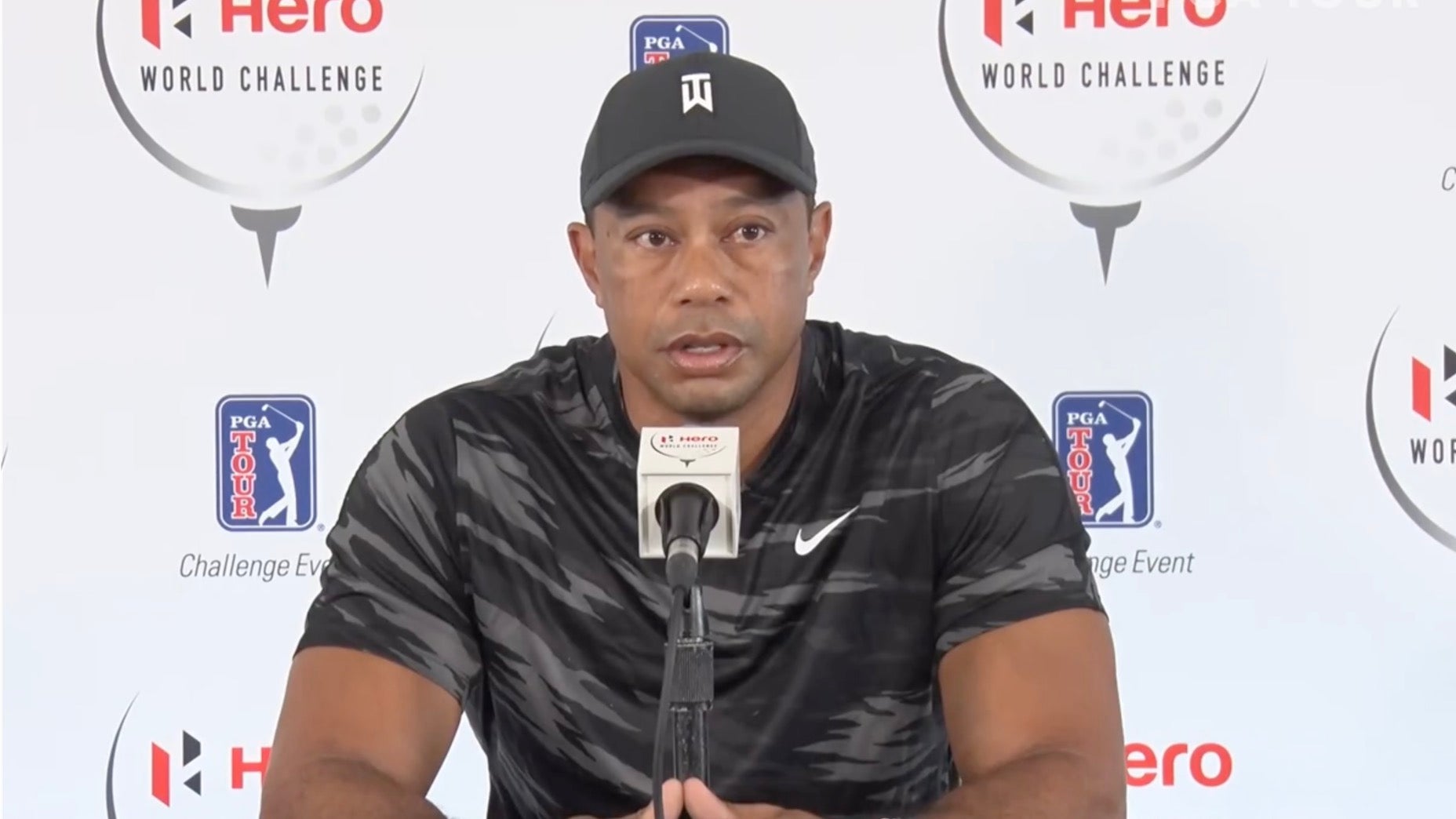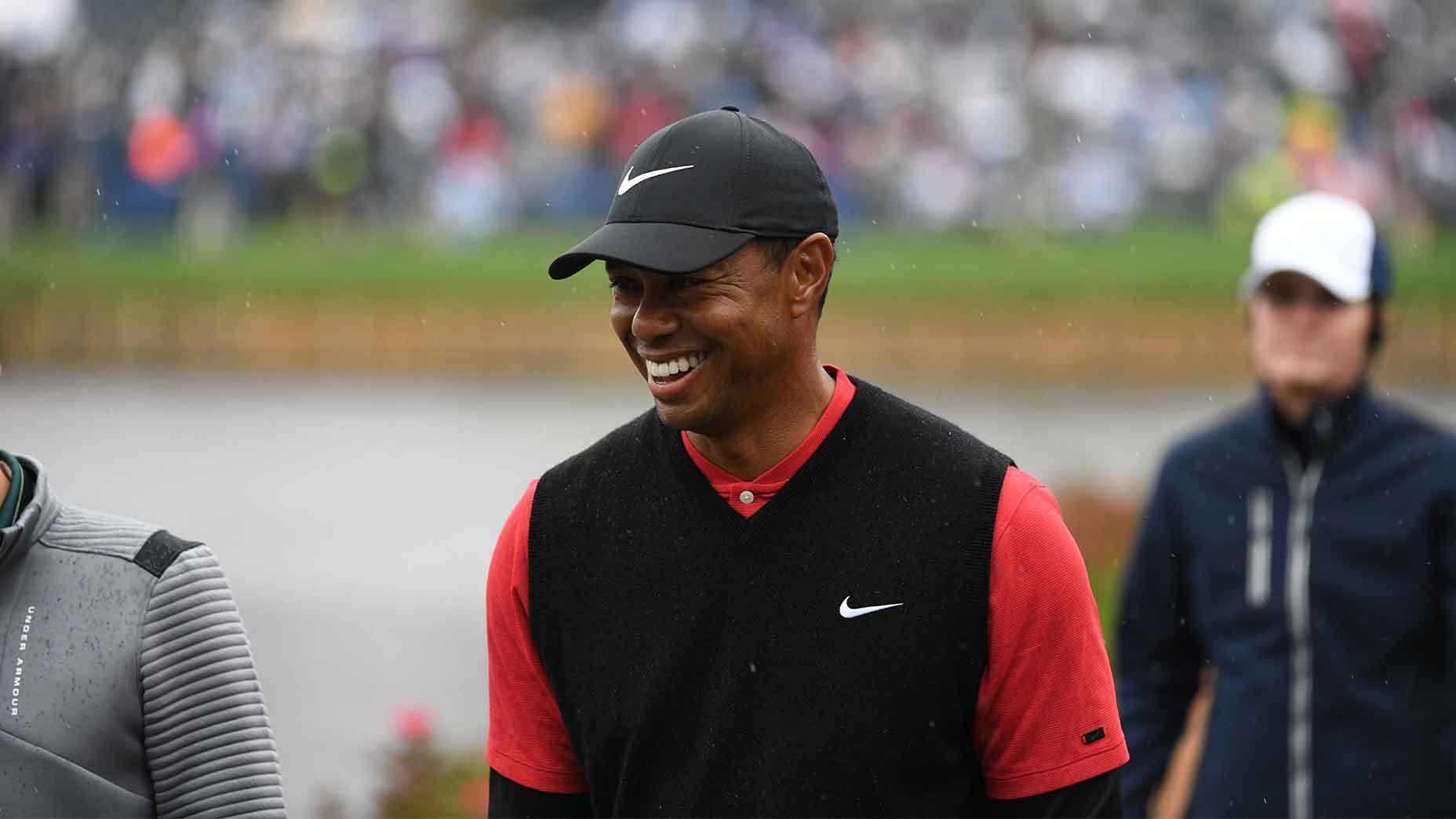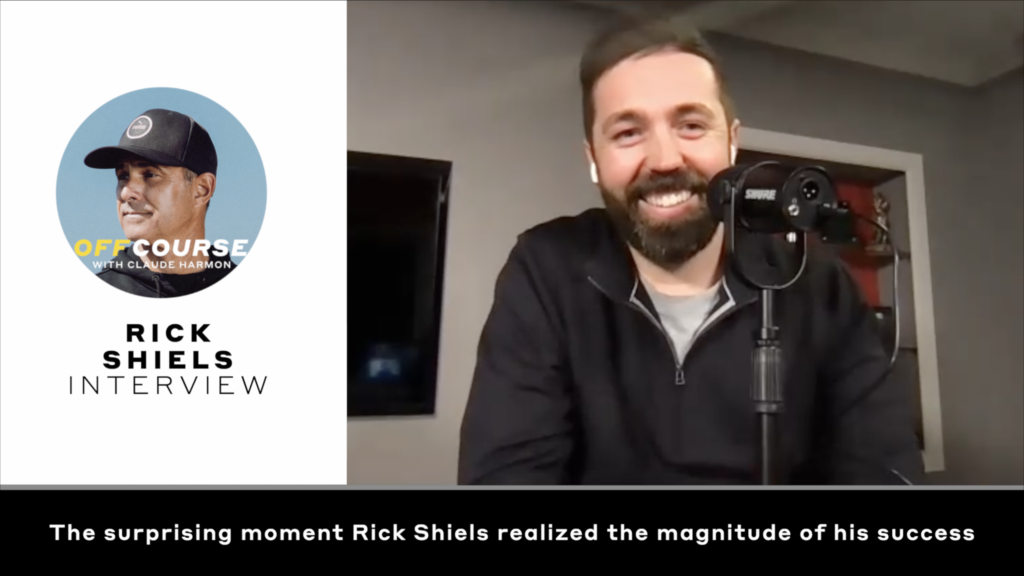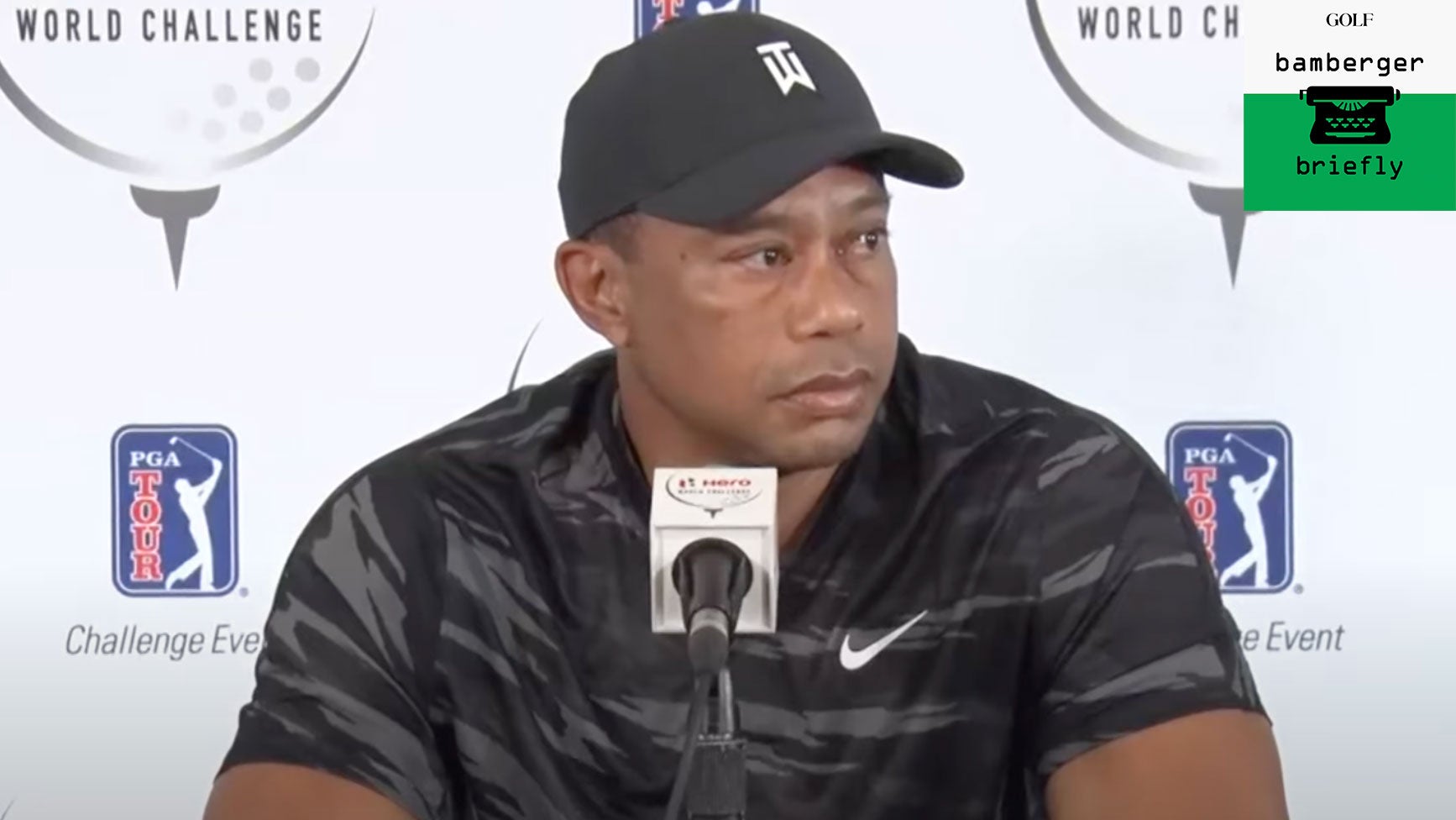
Tiger Woods during his Tuesday press conference at the Hero World Challenge.
Suddenly, we’re seeing a lot of Tiger Woods.
Swinging that golf club in the no-audio tweet you posted last week! (A backyard short iron, perfect plane, Larry Mize rhythm.)
Making that grand entrance for your at-home, no-hat Golf Digest interview, posted on Monday, with Henni Zuël Koyack! (The pooch stays in the picture.)
The no handlers, no follow-ups exit you made from your Tuesday-morning press-tent interview in the Bahamas! (Hydration sip before getting up from the dais.)
After going dark for nine months — your “maternity leave,” as you amusingly put it to Koyak — you are suddenly back in our lives, controlling the narrative.
The actual lede is devastating:
At age 45, as the result of a scary, high-speed and unexplained single-vehicle, lone-driver car crash, Tiger Woods’ career and life has completely changed course.
He said it himself, in the Golf Digest interview and again talking to a small group of reporters in Albany, the Bahamas.
“I think something that is realistic is playing the Tour one day — never fulltime, ever again — but pick and choose, just like Mr. Hogan did. Pick and choose a few events a year and you play around that,” Woods told Koyack, who interviewed the 15-time major champion remotely.
In 1949, a Greyhound bus crashed into a Cadillac being driven by Ben Hogan, with his wife, Valerie. In his effort to save her life, Hogan saved his own. (He put his chest on her lap before the crash, like a human seat belt.) His injuries were devastating. He had already won three Grand Slam events. The legend of Hogan was created by what he did after that crash, playing a limited schedule and winning six more major titles. That’s why, to Woods and so many others, he is often referred to as Mr. Hogan.
“As far as playing at the Tour level, I don’t know when that’s going to happen,” Woods said at his Albany tournament, the Hero World Challenge, responding to a question from Steve DiMeglio of USA Today. “Now am I able to participate in the sport of golf now, to what level, I do not know that. I’ll keep you abreast, all of you abreast, as progress continues to go on, whether I’ll be out here, and at what level, and when.”
Woods’ fundamental modesty and shyness shows up in the most unexpected places, just as it did for two other of the game’s all-greats, Hogan and Mickey Wright: as progress continues. A passive construction; his avoidance of the word I.
Koyack, a handpicked interviewer who is friendly with Woods, did not ask any direct questions about Woods’ February car crash in Los Angeles. No surprise there. Golf Digest is owned by Discovery, Inc., which has a contractual relationship with Woods.
In Albany, the third reporter to ask a question was Mark Cannizzaro of the New York Post. He asked, “Tiger, I’m wondering what you remember of the accident. We all saw the result and it looked so horrifying and scary.”
Woods’ answer was terse and telling:
“All those answers have been answered in the investigation, so you can read about all that there in the post report.”
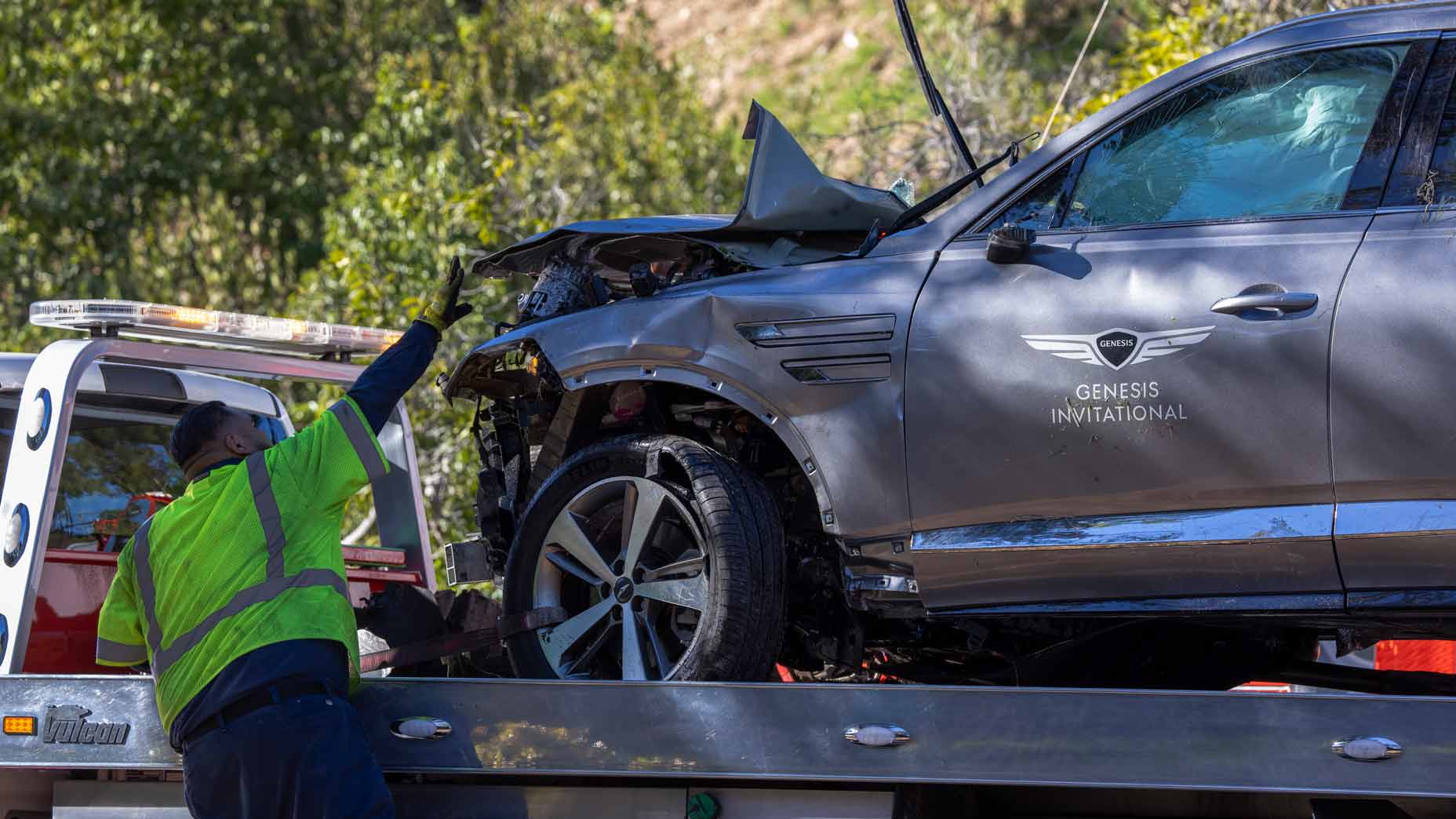
Woods’ vehicle soon after his February accident.
getty images
Police investigators in Los Angeles did not order any known toxicology reports from the crash. Woods states in the report that he has no recollection of the Feb. 23 crash, in which he was driving nearly twice the posted 45-mile-an-hour speed limit for a period before driving over a median and, at 75 miles an hour, into a tree. He was wearing a seat belt and the air bags were deployed.
Woods’ own Twitter feed cited a statement from the UCLA hospital where he was being treated on an emergency basis for “significant” leg fractures and other issues. Different parts of his lower body were stabilized with a surgical rod as well as pins and screws. Woods has also had five back surgeries and five knee surgeries.
“I’m lucky to be alive but also still have the limb,” Woods said, after mentioning the post-crash discussion of possible amputation of his right leg. “Those are two crucial things. I’m very grateful that someone upstairs was taking care of me, that I’m able to not only be here but also to walk without a prosthesis.”
Stunningly, in both the Golf Digest interview and in the Hero press conference, Woods said, convincingly, that he can accept that his life has changed course.
“I won’t have the opportunity to practice, given the condition of my leg, and build up. I just don’t. I’ll just have a different way of doing it and that’s okay. I’m at peace with that. I’ve made the climb enough times.”
All the damage Woods did to his body over the years, by his own admission, came from his obsessive desire to improve and to win. Now he is saying that, as a result of a devastating single-driver car crash, his body is saying enough.
His interior life — his mental state — is off limits to outsiders. He has always been this way.
The final three-sentence question at the Albany press conference came from Fatiha Sahnoune, a French golf writer. Her second sentence contained one of the most original questions ever posed to Woods. Her third sentence gave Woods the out he seized.
“You expressed your body pain before. Could you express your mind feelings? And in the meantime, could you explain to us the goal of your foundation for the future?”
Woods skipped right past “mind feelings.” He did speak about his foundation work. He showed at other times his commitment to the education of kids in need. In the Golf Digest interview, he seemed to enjoy the opportunity to talk about his efforts to help his son with his own golf-course mind feelings.
“Right now, we’re at two million youths served,” Woods said. “I think we can do more.”
On Tuesday, on three occasions, questions were preceded by some sort of greeting.
“Tiger, it’s great to see you looking healthy.”
“Tiger, welcome back.”
“Good to have you back, Tiger.”
Each time, Woods’ face revealed nothing. It was impassive. The public side of his singular golfing life has never come naturally to him. On the other hand, his various ambitions require him to sit in front of reporters. He’s done it hundreds and likely thousands of times.
On one occasion, responding to a personal entreaty from a reporter, Woods showed a smidgen of warmth. That was to the veteran Australian golf writer Bernie McGwire. Hero is a maker of motorcycles, among other things. Once, at the first Hero World Challenge, McGwire asked Woods if he had ever ridden a motorcycle. No, Woods said. The implication was obvious: motorcycles can be dangerous and one mistake could cost Woods dearly.
On Tuesday, Woods had this exchange with McGwire:
“Good to see you again at a golf tournament.”
“Thanks, Bernie.”
“I was going to ask you, are you in any pain, sitting there now?”
“Yeah.”
“I don’t want to get too personal, but what are you experiencing there at the moment, sitting there?”
“My back hurts and my leg hurt.”
There was a cart with a driver waiting for Woods, right outside the press-tent door.
Michael Bamberger welcomes your comments at Michael.Bamberger@Golf.com


